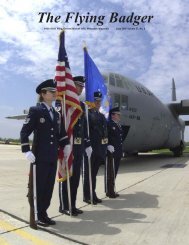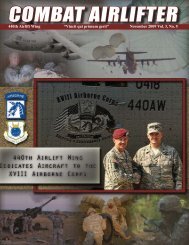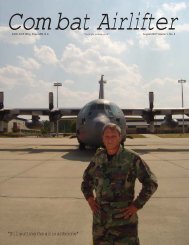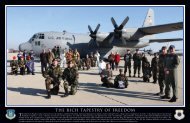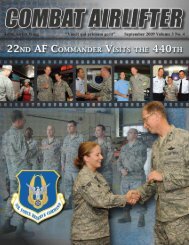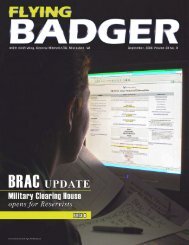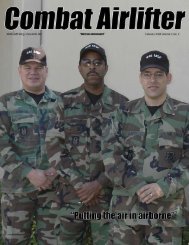On the cover...photo by Tech. Sgt. Mark MunseyKenyan and American paratroopersboard a C-130 Hercules en route to adrop zone June 6. Activited <strong>440th</strong>aircrew flew 140 Kenyan paratroopersin successful jumps during the threeday,14-drop mission.The Flying Badger<strong>July</strong> 2005Volume 57 Number 7Contents of the Flying Badger arenot necessarily the official view of,or endorsed by, the U.S.government, Department ofDefense or Department of the AirForce. Content is compiled,originated and developed by thePublic Affairs staff of the <strong>440th</strong><strong>Airlift</strong> <strong>Wing</strong>, Air Force ReserveCommand.<strong>Wing</strong> CommanderCol. Merle D. HartDirector, Public AffairsDennis J. Mehring<strong>Wing</strong> Chief, Public AffairsMaj. Ann Peru KnabePublic Affairs StaffCapt. Keith LeistekowTech. Sgt. Steve StaedlerStaff Sgt. Denise QuasiusSenior Airman Deanne PerezAirman Amanda HillAnn F. SkarbanLiz A. StoeckmannJoAnn LindnerFlying BadgerEditorial ContactMelissa KimballOffice of Public Affairs<strong>440th</strong> <strong>Airlift</strong> <strong>Wing</strong>300 East College AvenueGeneral Mitchell ARS, WI 53207Phone: 414-482-5481FAX: 414-482-5913www.afrc.af.mil/440awCOMMAND PERSPECTIVEBRAC proposal affects us allby Col. Michael Pierce<strong>440th</strong> <strong>Airlift</strong> <strong>Wing</strong>Vice CommanderMajor General David Tanzi, vicecommander of AFRC, hosted ateleconference for all AFRC basesand their senior leaders inpreparation for the May 13 BRAClist announcement. Two thoughtsimmediately came to mind as hebegan the teleconference. “Wow, thisteleconference is working, and I hopewe don’t need this information.”Family Support used part of theteleconference to brief people on theemotional reactions that a baseclosure nomination would generate.Colonel Merle Hart, commander ofthe 440 th , invited our FamilySupport staff to view this portionof the teleconference.Two thoughts came to my mindas AFRC’s Family Support staffgave their briefing. “Wow, they havethis down to a science and I hope wedon’t need this information.”Friday morning, May 13, Lt.Gen. John Bradley, AFRCcommander, was on the phone withthe unfortunate news that GeneralMitchell Air Reserve Station is onthe BRAC list. Wow! I neverthought we would be on the list.The Commander’s Action Line isdesigned as a tool for reservists toask questions anonymously.Current questions focus on theproposed Base Realignment andClosure List that was releasedMay 13.Under the current proposal, is theAir Force Specialty Code manningaffected at all? Will this be lookedat as downsizing?The proposal is the Air Force’sway of thinking smart andstreamlining, almost as if we werea business. As far as I know, noneof the positions will be eliminatedunder the new proposal, but thewing will move to the newlocation.The emotional reactions beganimmediately: disbelief, shock andanger. These reactions ran throughthe entire wing staff including me.I was surprised by the accuracy ofthe Family Support briefing anddisappointed in myself for allowingsuch an emotional reaction.After a weekend of reflection, Iestablished a three-part plan for myfuture with BRAC.First, change is inevitable andbrings new opportunities.Therefore, BRAC is going to bringchanges that will bringopportunities for everyoneinvolved. Also, I will avoid rumorsand focus on facts to find theopportunities. This will keep mepositively motivated and avoidemotional swings during thecomplex BRAC process.Second, I will remain focusedon my mission. If we allow BRACto distract us from our mission, itcould lead to unfavorable outcomes.Therefore, our success depends onremaining focused and safelyexecuting our mission.Lastly, I will proudly serve mycountry wherever the wing flagmay fly. If our flag takes me toAfghanistan, Iraq or NorthCommander’s Action LineWhat kind of response has the 440 thgotten from local communities likeSt. Francis, Cudahy, Oak Creek andSouth Milwaukee?We have seen an overwhelmingamount of support from local andstate governments. Our senators,representatives and local electedofficials all seem unified in trying tokeep the 440 th in Milwaukee,regardless of party line.Can I contact my congressionalrepresentatives and senators on thisissue?Yes – but you can’t do it from agovernment computer, or ongovernment time, or on agovernment phone. Our reservistsphoto by Maj. Ann Peru KnabeCol. Michael PierceCarolina, I will proudly serve.BRAC is important for thesecurity of our country and thesecurity of our country is my job. Iwill stand by the BRAC decisionsand proudly serve my country foras long as possible. Yes, it isunfortunate that our Air Reservestation is on the BRAC list butchange brings opportunities. I havea mission and will proudly servewherever and whenever called toduty.and civilian employees are allindividual citizens when they gohome at night, and as citizens weall have the right to contact ourlegislative leadership. The CapitalHill operator number is 1-888-762-8760.If you have a BRAC question forthe Commander’s Action Line,contact the Public Affairs Officeat 482-5482. All calls will remainanonymous.The current topic is BRAC, butother areas of concern can also beaddressed. The Flying Badger willpublish appropriate questionsthat apply to the majority of thebase population.Page 2 The Flying Badger <strong>July</strong> 2005
BATTLEFIELD AIRMAN<strong>440th</strong> takes Kenya military to new heightsby Tech. Sgt. Mark Munsey379th Air Expeditionary <strong>Wing</strong> Public AffairsNAIROBI, Kenya (AFPN) — As the sun roseJune 6, seven Airmen wearing desert flightsuitsstood outside the guarded entrance to JomoKenyatta International Airport waiting for theirpassengers.The C-130 Hercules crew, deployed toSouthwest Asia from the <strong>440th</strong> <strong>Airlift</strong> <strong>Wing</strong> werehandpicked to take several dozen Kenyan armyspecial operations forces’ paratroopers on theirfirst airdrop in nearly three years.“Because of the ... war on terrorism, theKenyans haven’t had access to a cargo plane inquite some time,” said Maj. Keith Wesley, 95th<strong>Airlift</strong> Squadron, aircraft commander.While the airport ground crew fueled the C-130, U.S. and Kenyan troops prepared for thefirst of their 14 drops over the next three days.The Air Force was just the latest Americanmilitary branch to help the Kenyans achieve theirtraining goal. Army special operations forces hadbeen on the ground and in the Kenyans’ classroomfor a month before the C-130 arrival.They were finally ready, but takeoff wasdelayed for close to an hour because of preflightpreparation as well as the late arrival of a Kenyansoldier.Before leaving the helicopter that brought himin, the uniform-clad passenger was familiar byposition, if not by name, to Lt. Col. Bob Berman,a C-130 mission officer in charge.“I’m betting this is the army general comingin to talk to his troops,”Colonel Berman surmised.Talk, no. Grab a ‘chute, yes.“I saw real leadership today, watching thegeneral be the first Kenyan leading his troops offthe ramp,” said Capt. Brad James, a <strong>440th</strong> <strong>Airlift</strong><strong>Wing</strong> reservist serving as the mission co-pilot.Captain James flew the second plane full ofparatroopers later that morning.As the C-130 raced over the African terrain, ateam was at the drop zone contending with alast-minute obstacle. They were clearing awaymyriads of local four-legged inhabitants, amongthem lions, tigers and zebras.“It’s like jumping into a zoo,” said Army Sgt.1st Class Michael Ray, a paratrooper and medic.The “10-minute warning” soon became “twominutes to the zone.” In the cargo compartmentstood American and Kenyan forces eager topractice what the U.S. Army had preached in theclassroom.Soon enough the signal for 30 seconds wasgiven. Then, faster than it seemed, the “fivesecondwarning” motivated the 12 chute-wearingwarriors to take a deep breath before plunging1,250 feet.One large leap for Kenyan paratroopers, onelarger leap in the fight against instability andterrorism for the region, Major Wesley said.Then he turned the Hercules to the left andcircled around for the next wave of Kenyan skyjumpers.In all, more than 140 paratroopers jumpedfrom the aircraft.photo by Tech. Sgt. Mark MunseyKENYA — Master Sgt. Dan Schmitz, <strong>440th</strong> Maintenance Squadron, conducts a final check of a C-130 Hercules before departure June 6. More than 140U.S. and Kenyan Army paratroopers left the Kenyan army base landing strip and made successful jumps during the three-day, 14-drop mission. Whileactivated, Sergeant Schmitz is a crew chief with the 746th Expeditionary <strong>Airlift</strong> Squadron at a forward-deployed location.The Flying Badger <strong>July</strong> 2005 Page 3



